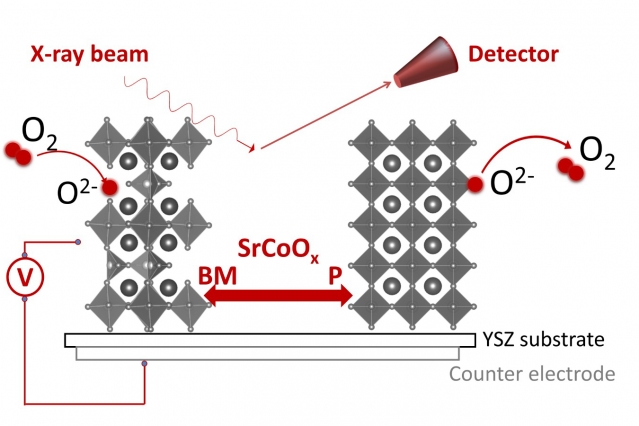Jan 20 2016
Researchers at the Massachusetts Institute of Technology (MIT) have produced a thin-film material whose electrical and phase characteristics can be altered between two crystal states - one semiconducting and one metallic - by applying an electrical charge.
 This diagram shows how an electrical voltage can be used to modify the oxygen concentration, and therefore the phase and structure, of strontium cobaltites. Pumping oxygen in and out transforms the material from the brownmillerite form (left) to the perovskite form (right).
This diagram shows how an electrical voltage can be used to modify the oxygen concentration, and therefore the phase and structure, of strontium cobaltites. Pumping oxygen in and out transforms the material from the brownmillerite form (left) to the perovskite form (right).
This thin-film material, called strontium cobaltite (SrCoOx), remains in its new configuration until another voltage is applied, reverting it back to its previous state. The findings show potential for developing a next-generation, "nonvolatile" computer memory chip that can retain data in the absence of power. They also hold significant promise for catalytic applications and energy conversion. The results of the study have been published in the journal, Nano Letters.
The novel material was developed by Qiyang Lu, MIT materials science graduate student, and associate professor Bilge Yildiz, also from MIT. The material’s pressure, temperature and composition collectively control its structural phase.
Here for the first time, we demonstrate that electrical bias can induce a phase transition in the material. And in fact we achieved this by changing the oxygen content in SrCoOx.
Bilge Yildiz, Associate Professor, MIT
“It has two different structures that depend on how many oxygen atoms per unit cell it contains, and these two structures have quite different properties,” Lu explained.
Perovskite and brownmillerite were the two configurations of the molecular structure. When the concentration of oxygen is high, a cage-like and tightly enclosed crystal structure of perovskite is produced, and when the oxygen concentration is low a more open structure of brownmillerite is produced. The researchers observed that both of the forms display different physical, chemical, magnetic, and electrical properties. They also discovered that by applying a small amount of voltage (0.03 V), the thin-film material could be switched between the two crystal states. Once the material is changed to its new configuration, it stays stable until it is switched back by applying voltage again.
SrCoOx belongs to a group of materials called transition metal oxides. Such materials hold immense possibilities in a wide range of applications, such as membranes that allow the passage of oxygen for gas isolation, use of electrodes in fuel cells, and memristor - an ultrafast, nonvolatile, and energy-efficient memory device. According to the researchers the phase transition, induced by a small electrical charge, could allow these materials to be used in many potential applications.
Past studies dedicated to strontium cobaltites relied on changes occurring in the oxygen concentration within the gas atmosphere. This way, either form taken by the material could be controlled. However, this process was slower and difficult to control. Lu said; “So our idea was, don’t change the atmosphere, just apply a voltage.”
Voltage modifies the effective oxygen pressure that the material faces.
Bilge Yildiz, Associate Professor, MIT
To develop the new material, the team deposited a thin-film material - the brownmillerite phase - onto an yttrium-stabilized zirconia, which was used as a substrate. When voltage was applied to this setup, oxygen atoms entered the material. This effect was reversed when the opposite voltage was applied.
In order to show that the material experiences a phase change following the application of voltage, the researchers used an in-situ X-ray diffraction technique at MIT's Center for Materials Science and Engineering. The basic concept of altering gas pressure and temperature in the environment for switching materials between two phases, was developed recently by Oak Ridge National Laboratory scientists.
While interesting, this is not a practical means for controlling device properties in use.
Bilge Yildiz, Associate Professor, MIT
The MIT team have enabled the control of the electrical and phase properties of this class of materials in a practical manner - using an electrical charge. Lu claimed that this class of materials could be used in electrodes and fuel cells for lithium ion batteries, in addition to memory devices.
Our work has fundamental contributions by introducing electrical bias as a way to control the phase of an active material, and by laying the basic scientific groundwork for such novel energy and information processing devices.
Bilge Yildiz, Associate Professor, MIT
The researchers have collaborated with MIT professor Harry Tuller to further explore the electronic characteristics of the material in its varied structures, and to apply this concept to other target oxides for applications in energy and memory.
It paves the way for the application of these materials both in solid state electrochemical devices for the efficient conversion of energy or oxygen storage, as well as in possible applications in a new kind of memory devices.
José Santiso, Nanomaterials Growth Division Leader, Catalan Institute of Nanoscience and Nanotechnology
The National Science Foundation funded the study.